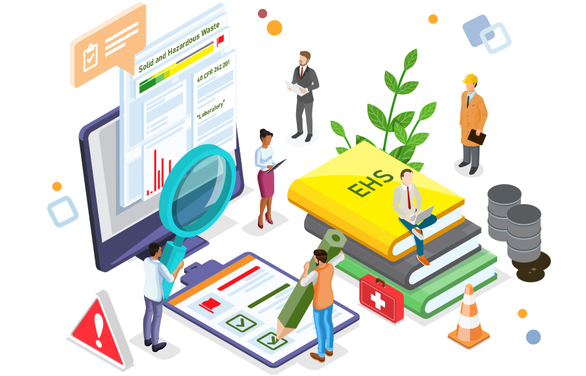EHS Technology & Audits
In today’s fast-evolving business landscape, where companies are under increasing pressure to meet regulatory standards, reduce environmental impact, and ensure the safety of their workforce, EHS (Environment, Health, and Safety) functions have taken center stage. Once seen as compliance-driven obligations, EHS initiatives are now strategic imperatives—critical to operational resilience, brand reputation, and long-term sustainability.
Learn More
6/11/20254 min read


In today’s fast-evolving business landscape, where companies are under increasing pressure to meet regulatory standards, reduce environmental impact, and ensure the safety of their workforce, EHS (Environment, Health, and Safety) functions have taken center stage. Once seen as compliance-driven obligations, EHS initiatives are now strategic imperatives—critical to operational resilience, brand reputation, and long-term sustainability.
And at the heart of this transformation lie two key drivers: EHS Technology and Audits.
In this blog, we explore how modern EHS technologies are revolutionizing traditional safety and environmental audits, the benefits they offer, and why organizations need to embrace this digital transformation sooner rather than later.
What is EHS Technology?
EHS technology refers to the software, platforms, and digital tools that help organizations manage environmental, health, and safety programs efficiently. These tools can include:
EHS management software (e.g., Enablon, Sphera, Intelex)
Mobile safety inspection apps
IOT-enabled safety sensors
Environmental monitoring systems
Incident reporting and tracking platforms
Risk assessment and audit automation tools
By digitizing and centralizing EHS data, these technologies enable real-time tracking, better decision-making, and faster response to risks or non-compliance.
The Role of EHS Audits in Business Success
An EHS audit is a systematic, objective evaluation of an organization’s compliance with safety, health, and environmental regulations, policies, and internal procedures. Audits can be:
Internal or external
Compliance-based or performance-driven
Routine or event-triggered (e.g., post-incident)
Audits ensure that operations meet legal standards and that risks are proactively identified and mitigated. With the addition of technology, these audits are becoming more accurate, efficient, and predictive.


EHS Technology & Audits: Transforming Safety, Compliance, and Sustainability
Why Technology-Enabled EHS Audits Are Better Than Traditional Ones How EHS Technology is Transforming the Audit Process
1. Real-Time Data Collection & Remote Auditing
Gone are the days of clipboards, spreadsheets, and paper checklists. EHS software allows auditors and safety managers to:
Conduct mobile inspections using tablets or phones
Collect data on-site and upload it in real-time
Access remote locations using drones or IoT sensors
Perform remote audits with digital access to documentation and systems
This enables faster, more comprehensive audits with fewer logistical barriers.
2. Automation and Workflow Integration
Modern EHS platforms automate routine tasks such as:
Scheduling audits
Sending reminders and notifications
Assigning corrective actions
Escalating overdue tasks
This not only reduces manual errors but ensures that nothing falls through the cracks, increasing audit effectiveness.
3. Advanced Analytics & Predictive Insights
One of the biggest advantages of digitizing EHS audits is data-driven insight.
Analytics tools can identify:
Repeating audit findings
High-risk sites or departments
Root causes of incidents
Seasonal trends in non-compliance
Even better, predictive analytics use historical data and AI to forecast potential safety issues before they occur, allowing for preemptive action.
4. Centralized Dashboards and KPI Tracking
Executives and EHS managers can now track:
Audit completion rates
Outstanding corrective actions
Compliance scores
Safety lagging and leading indicators
All from a single dashboard, with visual graphs and trendlines. This helps ensure accountability at all levels.
5. Enhanced Collaboration Across Teams and Locations
Global companies often struggle to standardize EHS practices across locations. With cloud-based technology, every site, department, and contractor can:
Access a shared audit framework
Use standardized checklists
Submit reports to a unified platform
This results in consistent practices, easy benchmarking, and improved global compliance.
6. Document Control and Regulatory Readiness
Audits often fail due to poor documentation. EHS platforms store:
Permits and licenses
Inspection reports
Training records
SOPs and MSDS sheets
This ensures that everything is audit-ready, and documentation can be retrieved instantly during inspections or investigations.
Aspect
Traditional Audits
Tech-Enabled Audits
Data Collection
Manual, paper-based
Real-time, mobile-based
Accuracy
Prone to errors
Standardized & validated
Accessibility
Limited by location
Cloud-based, global
Reporting
Time-consuming
Instant dashboards
Follow-up
Easily missed
Automated workflows
Analysis
Reactive
Predictive
Scalability
Difficult to scale
Easily scalable
The Sustainability Angle: Environmental Compliance & ESG Reporting
Environmental compliance is no longer just about avoiding fines—it’s a key part of a company’s ESG (Environmental, Social, Governance) strategy.
EHS technology helps companies:
Track emissions, waste, water usage
Monitor permit exceedances in real-time
Automate reporting for ESG or CSR disclosures
Align with ISO 14001, GRI, and other global standards
With regulations like EU CSRD and SEC climate disclosure rules coming into effect, the ability to digitally track and report environmental impact is not optional—it’s essential.
Real-World Use Case: EHS Tech in Action
Case Study: A Global Manufacturing Firm
Challenge: Multiple sites, inconsistent audit practices, and reactive incident response.
Solution: Deployed an EHS software platform with mobile audit tools and centralized dashboards.
Results:
Audit cycle time reduced by 40%
Incident reporting improved by 60%
Compliance score increased across all regions
Management now receives monthly risk heatmaps
This transformation wasn’t just about better audits—it improved safety culture, regulatory confidence, and executive-level visibility.
Implementing EHS Technology: Key Considerations
1. Choose the Right Platform
Look for:
Customizable audit templates
Mobile access
Integration with other systems (HR, ERP, etc.)
Regulatory update support
2. Train Your Teams
Even the best tech fails without user adoption. Provide:
On boarding sessions
Refresher courses
In-platform tutorials
3. Start Small, Scale Fast
Pilot the technology in a few sites or functions. Learn, refine, then expand.
4. Ensure Data Security
EHS data includes sensitive information. Choose providers with:
ISO 27001 or SOC 2 compliance
Role-based access controls
Regular backups
The Consultant's Role: Making It All Work
While software providers offer the tools, EHS consultants ensure that:
The right audits are configured for your risks
Your team understands and adopts the platform
Insights from audits are turned into meaningful actions
You remain up-to-date with ever-changing regulations
Technology is the “what”; consulting is the “how”.
Conclusion: The Future of EHS is Digital, Predictive, and Strategic
As industries become more complex, and expectations around safety, compliance, and sustainability rise, businesses can no longer rely on spreadsheets and reactive audits.
By investing in EHS technology, organizations unlock a new level of transparency, efficiency, and foresight. Coupled with expert-led audits, this digital approach enables companies to move from “checking boxes” to driving real, lasting safety and environmental performance.
EHS audits powered by modern technology don’t just identify problems—they prevent them.
Need Help Going Digital?
If you're ready to modernize your EHS audit program, our consultants can:
Recommend the right technology stack
Build digital audit frameworks tailored to your industry
Train your staff and streamline adoption
Contact us today for a free assessment or demo!
Our Address
5A/3, Ratan Nagar, Teen Dukan, Dehar Ka Balaji, Jaipur, 302039, Rajasthan
greendashindia@gmail.com
+91-8003097697
About Us
Greendash provides consultancy in environment, health, safety, and fire protection, ensuring compliance and sustainability across various industries in India.
Useful Links
Contact...
